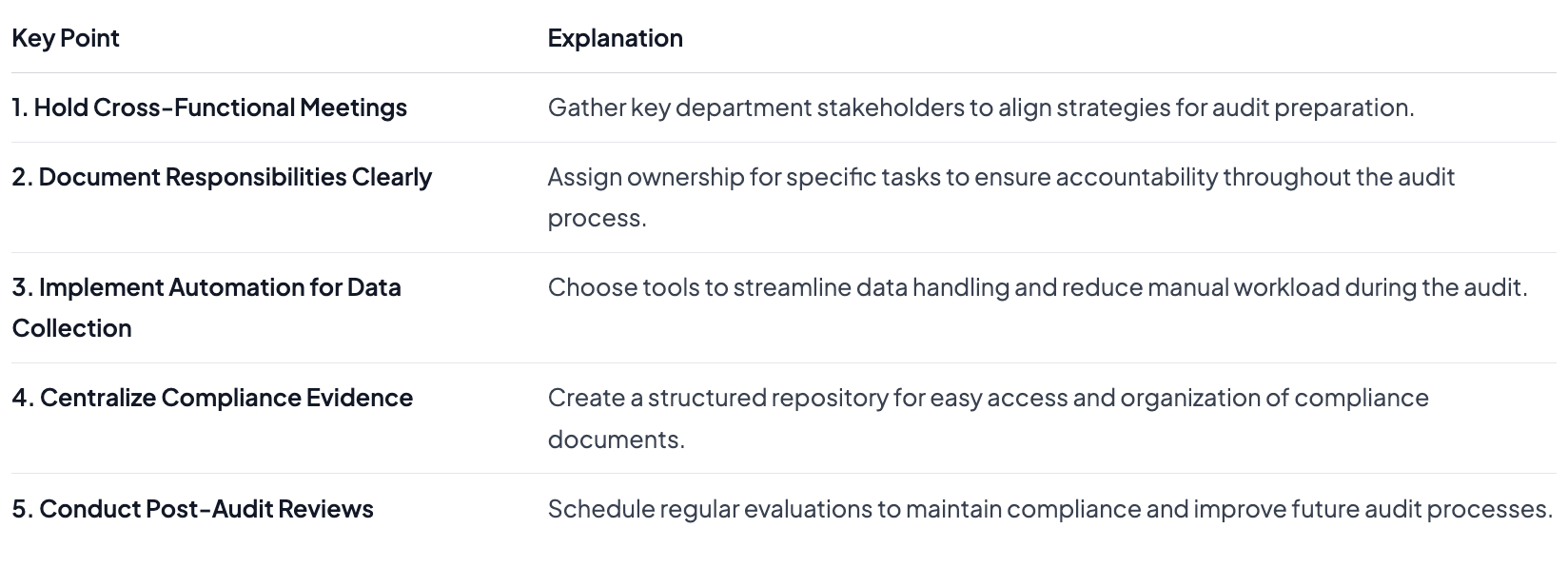Did you know that organizations with strong internal alignment are up to 50 percent more likely to achieve successful audit outcomes? Preparing for a GRC audit can feel complex, yet the right approach not only reduces stress but also positions your team to meet every challenge with confidence. By following the steps outlined here, you will discover practical ways to streamline audit readiness, optimize collaboration, and build a foundation for lasting compliance success.
Table of Contents
- Step 1: Assess Audit Readiness With Internal Alignment
- Step 2: Configure Automation Tools For Efficient Data Collection
- Step 3: Centralize And Document Compliance Evidence
- Step 4: Collaborate To Address Audit Findings And Gaps
- Step 5: Verify Audit Completion And Ensure Continuous Improvement
Quick Summary

Step 1: Assess audit readiness with internal alignment
Effective internal alignment sets the foundation for a smooth and successful GRC audit. This step helps your team synchronize strategic objectives and create a unified approach to audit preparation.
Start by convening a cross functional meeting with key stakeholders from departments including finance, legal, IT security and operations. According to research from the Institute of Internal Auditors, aligning the internal audit department with organizational strategic plans ensures critical synergy and supports broader business objectives.
During this meeting, map out your organization’s current strategic goals and identify potential compliance gaps. The GQM+Strategies research highlights the importance of harmonizing organizational goals, strategies and measurements to enhance overall clarity. Focus on creating a shared understanding of audit requirements across different teams.
Pro Tip: Document your alignment discussions and create a centralized reference document that all team members can access and review.
Ensure each department understands its specific responsibilities in the audit process. Assign clear ownership for collecting documentation, responding to potential auditor inquiries and managing compliance evidence. Establish a timeline and set realistic milestones for audit preparation.
Here’s a summary of the key actions and best practices for internal alignment in audit readiness:\

By taking a collaborative and strategic approach to internal alignment, you transform audit preparation from a stressful event into a structured organizational process. Understanding SOC 2 AICPA can provide additional context for creating a robust compliance framework.
With your internal teams now aligned and expectations clearly communicated, you are ready to move forward to the next stage of audit readiness preparation.
Step 2: Configure automation tools for efficient data collection
Configuring automation tools transforms your GRC audit process from a manual slog into a streamlined strategic operation. This step will help you select and implement tools that dramatically reduce administrative overhead and improve data collection accuracy.
Begin by evaluating your current data collection workflows and identifying repetitive tasks suitable for automation. According to research from Drata, continuous security monitoring and automated evidence collection can significantly streamline risk assessments and audit preparation.
Select automation tools that integrate seamlessly with your existing technology stack. Look for platforms offering real time compliance tracking robust API connections and the ability to pull data from multiple sources. The Case for Security Questionnaire Automation highlights the critical importance of choosing tools that match your organizational complexity.
Pro Tip: Prioritize tools with customizable workflows that can adapt to your specific compliance requirements.
Implement role based access controls to ensure data security during automated collection. Configure permission levels that allow relevant team members to view and contribute data while maintaining strict confidentiality protocols.
Test your automation configuration thoroughly before full deployment. Run pilot programs to validate data accuracy integration capabilities and overall system performance. Validate that automated tools capture all necessary compliance evidence without manual intervention.
By strategically configuring automation tools you will create a more efficient resilient audit preparation process that reduces human error and accelerates your overall compliance workflow.

With your automation tools now configured youre ready to move forward to the next critical stage of your GRC audit preparation.
Step 3: Centralize and document compliance evidence
Centralizing and documenting compliance evidence transforms scattered information into a powerful strategic asset for your GRC audit. This critical step ensures your organization has a comprehensive organized repository of all necessary documentation.
Begin by creating a unified digital repository that can house all compliance related documents. According to research from Drata, automating real time evidence collection from integrated systems simplifies audit preparation and ensures all necessary documentation is readily available.
Design a standardized folder structure that logically categorizes different types of compliance evidence. Group documents by department regulatory requirement and audit cycle. This approach makes it easy for auditors to navigate and quickly locate specific information when needed.
Pro Tip: Use metadata tagging to enhance searchability and create quick reference points for each document.
Implement robust access controls to manage document permissions. Ensure that sensitive compliance materials are accessible only to authorized personnel while maintaining transparency for relevant stakeholders. 7 Steps to Create a Complete SOC 2 Compliance Checklist provides additional insights into effective document management strategies.
Schedule regular review cycles to validate and update your centralized evidence repository. Remove outdated documents and ensure that the most current versions are always front and center. Automated tools can help flag documents that require periodic review or renewal.
By creating a centralized documentation system you transform compliance from a reactive task to a proactive strategic function. Your organized approach will significantly reduce stress during audit periods and demonstrate your organizations commitment to rigorous compliance management.
With your compliance evidence now centralized and meticulously documented you are well prepared for the next phase of your GRC audit journey.
Step 4: Collaborate to address audit findings and gaps
Addressing audit findings requires a strategic collaborative approach that transforms potential compliance weaknesses into organizational strengths. This step will help your team develop a unified response to identified gaps and create actionable improvement plans.
According to research from automation experts, collaborative efforts can significantly enhance data aggregation and prioritization of audit findings. Begin by scheduling a comprehensive cross functional meeting that includes representatives from IT security legal compliance and operations teams.
Create a structured gap analysis document that maps each audit finding to specific organizational responsibilities. Assign clear ownership for addressing each identified issue and establish realistic timelines for resolution. According to the ESASCF framework research, systematic collaboration allows organizations to efficiently identify and address security compliance challenges.
Pro Tip: Implement a color coded tracking system that visually represents the status of each finding from identification to resolution.
Utilize collaborative tools that enable real time tracking and communication. Ensure every team member can update progress view comments and share relevant documentation seamlessly. 7 Essential Tips for Every GRC Analyst to Succeed provides additional insights into effective team coordination.
Conduct periodic progress review meetings to assess implementation status and address any potential roadblocks. Maintain transparency by creating a shared dashboard that allows all stakeholders to monitor ongoing remediation efforts.
By approaching audit findings as a collaborative opportunity for improvement rather than a punitive process you transform compliance from a bureaucratic requirement into a strategic organizational strength.
With your team aligned and action plans in place you are now prepared to move forward in your GRC audit journey.
Step 5: Verify audit completion and ensure continuous improvement
Verifying audit completion marks the final critical phase of your GRC audit process where you transform insights into sustainable organizational improvement. This step ensures your team not only meets current compliance requirements but builds a robust framework for future success.
Conduct a comprehensive final review that cross validates all completed remediation activities. According to research from Scrut, implementing real time oversight with instant alerts can support continuous monitoring and risk management throughout your compliance journey.
Schedule a final validation meeting with key stakeholders to systematically review every addressed audit finding. Create a detailed report that documents the resolution process highlighting specific improvements implemented and lessons learned from the audit experience.
Pro Tip: Develop a standardized post audit reflection template to capture institutional knowledge and streamline future compliance efforts.
Establish a recurring quarterly review process to maintain momentum and prevent potential compliance drift. This proactive approach allows your organization to stay ahead of emerging regulatory changes and internal process improvements.
Understanding the GRC Framework: Key Concepts Explained can provide additional context for building a robust continuous improvement strategy.
Implement feedback mechanisms that allow team members to contribute insights and suggestions for enhancing future audit processes. Recognize and reward team contributions that demonstrate commitment to compliance excellence.
By treating the audit completion as a starting point for ongoing improvement rather than a finish line you transform compliance from a periodic requirement into a strategic organizational capability.
Congratulations. You have now successfully navigated a comprehensive GRC audit process that positions your organization for sustained compliance and strategic growth.
Accelerate Your GRC Audit with Skypher’s Intelligent Automation
Preparing for a GRC audit involves complex steps like internal alignment, centralized documentation, and handling audit findings collaboratively. These processes often create stress, slow down progress, and increase the risk of errors. If your team struggles to efficiently manage security questionnaires and compliance evidence, it is time to embrace automation that drives clarity and speed.
Skypher offers an AI-powered Questionnaire Automation Tool designed precisely to ease the burden of manual data collection and streamline your audit readiness workflow. By integrating with over 40 third-party risk management platforms and enabling real-time collaboration, Skypher helps your teams synchronize efforts, reduce administrative overhead, and improve accuracy across every stage of the audit.

Discover how your organization can transform audit preparation from a stressful challenge into a strategic strength. Visit Skypher today to explore how our customizable Trust Center and seamless API integrations empower faster security reviews and continuous compliance improvement. Start accelerating your GRC audit process now to build lasting operational confidence and maintain a competitive edge.
Frequently Asked Questions
What are the first steps to assess audit readiness for my B2B team?
Start by convening a cross-functional meeting with key stakeholders from departments like finance, legal, IT security, and operations. Aim to identify your organization’s strategic goals and any compliance gaps that need addressing.
How can we automate data collection for our GRC audit?
Evaluate your current data collection workflows and identify repetitive tasks suitable for automation. Choose automation tools that integrate with your existing technology stack to streamline processes and reduce administrative overhead.
What is an effective way to document compliance evidence before an audit?
Create a centralized digital repository for all compliance-related documents, organized by department and regulatory requirement. Use a standardized folder structure and apply metadata tagging to improve searchability and facilitate quick access.
How should my team address identified audit findings?
Schedule a comprehensive meeting to develop a unified response plan for each audit finding. Assign specific ownership for addressing gaps and establish timelines for resolution to ensure accountability and track progress.
How can we ensure continuous improvement after completing an audit?
Conduct a final review to cross-validate all remedial actions taken and create a comprehensive report of improvements. Establish a quarterly review process to maintain compliance momentum and prevent drift over time.
What key actions should we take to align our departments for a successful audit?
Gather representatives from finance, legal, IT security, and operations to discuss and document audit requirements. Clearly define departmental roles and responsibilities to create a unified approach to the audit preparation process.





